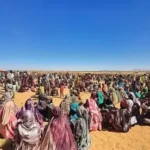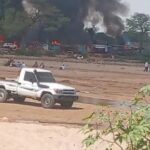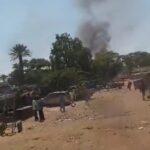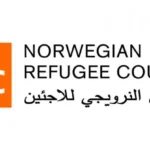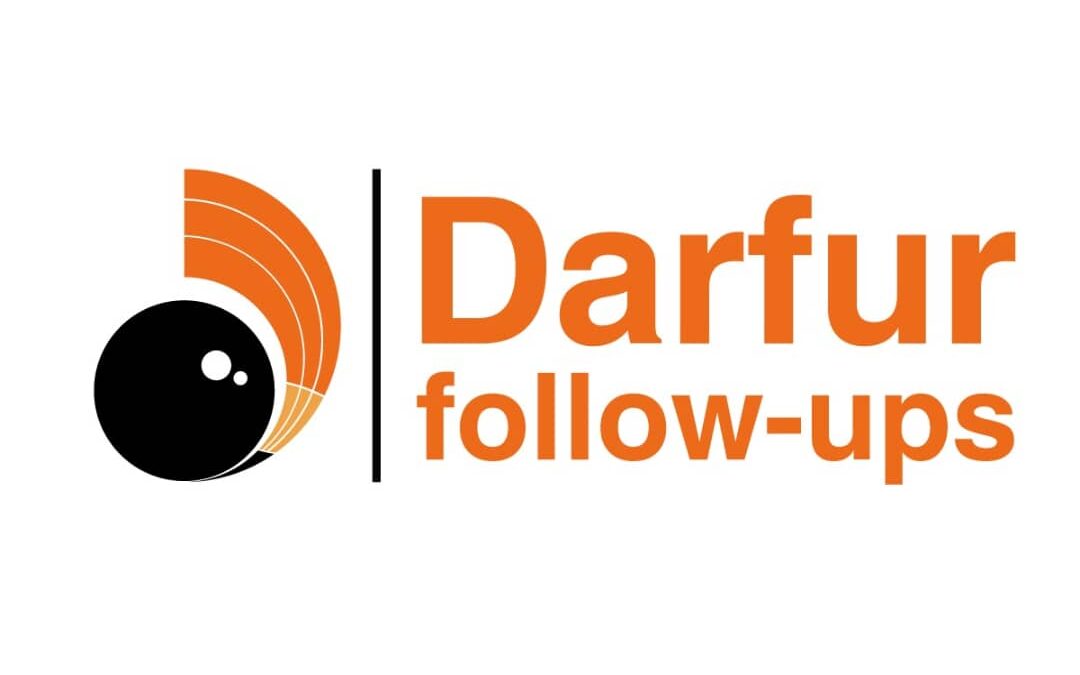Report by: Enaam Alnour
On a heavy evening, fragmented news trickled out of El-Fasher through intermittent Starlink calls and encrypted messages in private groups. The city had fallen militarily then communications fell with it. One question hung in the air: Who will tell what happened?
Sudan’s media space has turned into a parallel battlefield where every tool is weaponized language, religion, images, rumors, and even accusations of treason to construct a single narrative that erases all others. Misinformation and hate speech are no longer background noise; they have become direct instruments of violence, shaping who is spared and who is targeted.
A Darfur Follow-Ups report reveals how digital darkness has become a weapon reshaping memory, erasing truth, and leaving civilians without voice or protection.
Information as a Weapon — When News Becomes Ammunition
Since the war erupted on April 15, 2023, news has stopped being a reflection of reality and instead became a tool of war.
Multiple research reports issued in 2024 and 2025 confirm that Sudan is experiencing one of the most complex “information warfare” environments in Africa.
An Internews report (October 2025) described Sudan’s media landscape as “almost entirely collapsed,” calling social media “a lone refuge for information… and a goldmine for misinformation.”
A CDAC Network report (2025) went even further: “Harmful information in Sudan is not a by-product of the war… it is part of the military infrastructure itself, directly shaping displacement, aid distribution, and collective fear.”
A Chr. Michelsen Institute (CMI) report described the moment as a “digital war,” with all sides manipulating old images posed as new events, fabricated videos, fake accounts fueling hate campaigns, falsified battlefield victories, tampered satellite images, and misleading “maps” of displacement routes.
In Darfur especially where escape routes are narrow and deadly rumors travel faster than gunfire.
A single anonymous WhatsApp message about a “road ambush” can redirect thousands of fleeing families… even when completely false.
Another report from a digital-monitoring organization in the region shows that coordinated disinformation campaigns in Sudan don’t just distort battlefield facts they directly influence life-or-death decisions: routes of escape, trust in humanitarian actors, and whether to remain in a besieged city or flee.
A Parallel Battlefield — When the Narrative Becomes a Weapon
With every round of fighting in Khartoum or Darfur, artillery fire isn’t the only thing unleashed. A torrent of statements, videos, and live streams floods the digital space.
Recent studies on Sudan’s “digital war” show that social media has become a central arena for both hate speech and counter-efforts promoting verified information and peace messaging.
From the first days of the conflict, media-monitoring groups observed the army and the RSF racing to “occupy the timeline”: urgent statements claiming “crushing victories,” and photos of burnt vehicles attributed often without evidence to the opposing side, mutual accusations of massacres against civilians.
Alongside these, swarms of anonymous or fake accounts amplify rigid narratives “You are either with us or against us.”
This binary rhetoric turns any independent journalistic voice into a target of threats and smear campaigns.
The Army’s Narrative — State, Sovereignty, and “Fighting Terrorism”
In the Sudanese Army’s official statements and leadership speeches, the war is framed as a battle for “saving the state” or “defending dignity” from “a rebel militia threatening the unity of the country.” The RSF is portrayed as an external project or a “terrorist militia.”
By insisting on phrases like “regular forces” and “national sovereignty,” the army discursively equates any criticism of its conduct with belonging to the “fifth column” or siding with the enemy.
Analysts argue that the army increasingly relies on Islamist networks and political allies to mobilize public opinion, framing the war as a battle of identity not just a struggle for power.
Army-aligned media highlight RSF atrocities many of which are documented in rights reports while offering no real space to acknowledge abuses committed by government-linked forces elsewhere. Online, groups like “Sudanese Electronic Brigades” promote a unified narrative: “No voice is louder than the voice of battle.”
Any call for de-escalation or journalistic scrutiny is labeled betrayal. This narrative is not spontaneous; it is a deliberate strategy to preserve the army’s legitimacy locally and internationally. Whoever controls the “language of war” controls how the war will be remembered.
The RSF Narrative — Victimhood, Protection, and Digital Heroism
Across the divide, the RSF promotes its own narrative based on three pillars:
1. Historical Victimhood
The RSF presents itself as the voice of marginalized groups denied power for decades—casting the war as an “uprising of the peripheries.”
2. Claiming Protection of Civilians
RSF statements insist they target “remnants of the former regime” and protect civilians—despite UN and rights reports documenting patterns of executions, sexual violence, and widespread looting.
3. Digital Heroism
TikTok, Facebook, and X are flooded with videos of fighters laughing, firing on civilians, or posing with destroyed neighborhoods.
Some influencers abroad have become unofficial spokesmen, reframing atrocities as “heroic victories.”
A British newspaper revealed in October 2025 that a Sudanese influencer in Sheffield acted as a non-official RSF commentator, hosted live by fighters inside Darfur, glamorizing mass killing prompting X and YouTube to repeatedly ban his accounts.
SMEX reports (2024–2025) document RSF use of coordinated bot networks to amplify its messaging and attack critics.
This digital narrative resonates with disillusioned youth facing poverty and decades of political exclusion.
But it normalizes brutal violence—turning war crimes into shareable content.
The Internet as a Weapon of Siege
Sudan’s war of narratives cannot be understood without examining the weaponization of connectivity.
Since February 2024, Sudan witnessed one of the largest digital blackouts in the world. Major telecom services collapsed, leaving millions disconnected.
Rights reports warn the blackout disrupted humanitarian coordination, blocked families from sending remittances, and denied civilians information about safe escape routes.
Reports on internet freedom reveal that network shutdowns were not merely infrastructural they were often deliberate decisions by warring factions to impose blackout zones, suppress documentation of atrocities, and isolate communities.
Starlink emerged as a fragile lifeline in some areas Omdurman’s Karari district, pockets of Darfur but access became a new battleground:
Who controls the devices?
Who decides where they operate?
Are they used for humanitarian protection or to strengthen one side’s propaganda machine?
In Sudan, the internet became a scarce resource of power:
Those who control it speak.
Those who don’t are forced into silence.
Journalists in the Line of Fire — A Profession Turned Death Sentence
Amid this information chaos, journalists especially in Darfur stand at the center of the crossfire. Sudan has never seen such extensive targeting of the press.
Reports from RSF, CPJ, UNESCO, and others document systematic attacks by both sides and Sudan fell to 156th of 180 on the World Press Freedom Index.
UNESCO stated in June 2025: “Journalists in Sudan have become direct targets—killed, detained, tortured, and subjected to sexual violence.”
After the fall of El-Fasher in October 2025, journalists became prime targets , CPJ reports show 11–13 journalists were abducted or disappeared in days , Some resurfaced after escaping, Others vanished entirely amid testimonies of sexual violence by RSF fighters.
Groups of Sudanese journalists inside and outside Sudan issued open calls for international protection, safe corridors, and recognition of systematic attacks on the press as elements of war crimes.
The war on narratives is therefore not only between the army and the RSF , but against every independent voice trying to document reality.
The Public Between Propaganda and Distrust
The public is not a passive victim of this information war it is also a participant.
CDAC (2025) described Sudanese audiences as “both victim and actor.”
In displacement camps and hosting communities, information circulates through: Word of mouth , Conflicting stories travel from tent to tent with no way to verify, WhatsApp & Facebook groups Anonymous voice notes and images predict massacres, announce fake ceasefires, or warn of “booby-trapped roads.” , Social media feeds When the internet returns, it brings a flood of panic, trauma, and anger.
Studies show that the collapse of formal media pushed people toward non-professional sources even influencers with no access to the ground.
CSF’s 2025 report found hate speech to be a major driver of forced displacement; tribal incitement has ignited entire neighborhoods.
In this chaos, visual content even fabricated or from another context often feels more “real” to people than a written statement by a human rights organization “Images overpower text ,Shock overpowers verification.
Where Do Independent Platforms Stand? A Responsibility and an Opportunity
Independent media platforms face a difficult mandate: walking a tightrope between two armed forces, an exhausted population, and enormous psychological and security pressure on journalists.
Their role must go beyond reporting news and extend to: deconstructing propaganda, tracking hate speech, protecting journalists and sources, documenting the link between the battlefield and the battle for truth.
Who Owns the Narrative… and Who Pays the Price?
The real question is not merely: Who controls the narrative?
The army?
The RSF?
Diaspora activists?
International platforms?
The real question is: Who pays the price of that narrative?
The armed factions hold the guns.
But morally, the narrative belongs to civilians:
Those who lost homes, voices, and loved ones.
Those living on the edge of hunger, fear, and militarized propaganda that seeks to use them as fuel.
In a world that only remembers what is documented, the battle for narrative is inseparable from the battle for survival.
Unless independent media is designed to resist the war on truth as fiercely as civilians resist the war on their bodies, the world’s memory of Sudan will not reflect what we lived ,but what the architects of propaganda wanted told.



